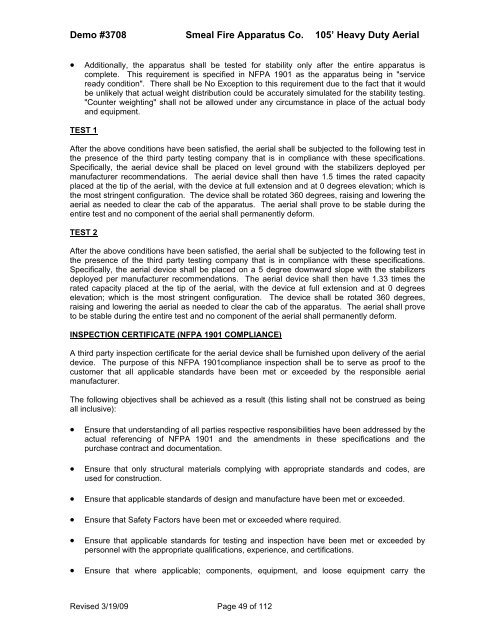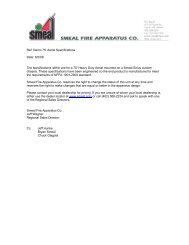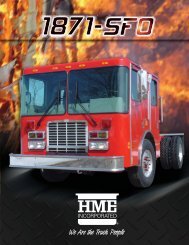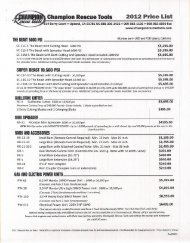Ref: Stock 105' Aerial Specifications - R & R Fire Truck Repair, Inc.
Ref: Stock 105' Aerial Specifications - R & R Fire Truck Repair, Inc.
Ref: Stock 105' Aerial Specifications - R & R Fire Truck Repair, Inc.
Create successful ePaper yourself
Turn your PDF publications into a flip-book with our unique Google optimized e-Paper software.
Demo #3708 Smeal <strong>Fire</strong> Apparatus Co. 105’ Heavy Duty <strong>Aerial</strong><br />
<br />
Additionally, the apparatus shall be tested for stability only after the entire apparatus is<br />
complete. This requirement is specified in NFPA 1901 as the apparatus being in "service<br />
ready condition". There shall be No Exception to this requirement due to the fact that it would<br />
be unlikely that actual weight distribution could be accurately simulated for the stability testing.<br />
"Counter weighting" shall not be allowed under any circumstance in place of the actual body<br />
and equipment.<br />
TEST 1<br />
After the above conditions have been satisfied, the aerial shall be subjected to the following test in<br />
the presence of the third party testing company that is in compliance with these specifications.<br />
Specifically, the aerial device shall be placed on level ground with the stabilizers deployed per<br />
manufacturer recommendations. The aerial device shall then have 1.5 times the rated capacity<br />
placed at the tip of the aerial, with the device at full extension and at 0 degrees elevation; which is<br />
the most stringent configuration. The device shall be rotated 360 degrees, raising and lowering the<br />
aerial as needed to clear the cab of the apparatus. The aerial shall prove to be stable during the<br />
entire test and no component of the aerial shall permanently deform.<br />
TEST 2<br />
After the above conditions have been satisfied, the aerial shall be subjected to the following test in<br />
the presence of the third party testing company that is in compliance with these specifications.<br />
Specifically, the aerial device shall be placed on a 5 degree downward slope with the stabilizers<br />
deployed per manufacturer recommendations. The aerial device shall then have 1.33 times the<br />
rated capacity placed at the tip of the aerial, with the device at full extension and at 0 degrees<br />
elevation; which is the most stringent configuration. The device shall be rotated 360 degrees,<br />
raising and lowering the aerial as needed to clear the cab of the apparatus. The aerial shall prove<br />
to be stable during the entire test and no component of the aerial shall permanently deform.<br />
INSPECTION CERTIFICATE (NFPA 1901 COMPLIANCE)<br />
A third party inspection certificate for the aerial device shall be furnished upon delivery of the aerial<br />
device. The purpose of this NFPA 1901compliance inspection shall be to serve as proof to the<br />
customer that all applicable standards have been met or exceeded by the responsible aerial<br />
manufacturer.<br />
The following objectives shall be achieved as a result (this listing shall not be construed as being<br />
all inclusive):<br />
<br />
<br />
<br />
<br />
<br />
<br />
Ensure that understanding of all parties respective responsibilities have been addressed by the<br />
actual referencing of NFPA 1901 and the amendments in these specifications and the<br />
purchase contract and documentation.<br />
Ensure that only structural materials complying with appropriate standards and codes, are<br />
used for construction.<br />
Ensure that applicable standards of design and manufacture have been met or exceeded.<br />
Ensure that Safety Factors have been met or exceeded where required.<br />
Ensure that applicable standards for testing and inspection have been met or exceeded by<br />
personnel with the appropriate qualifications, experience, and certifications.<br />
Ensure that where applicable; components, equipment, and loose equipment carry the<br />
Revised 3/19/09 Page 49 of 112







